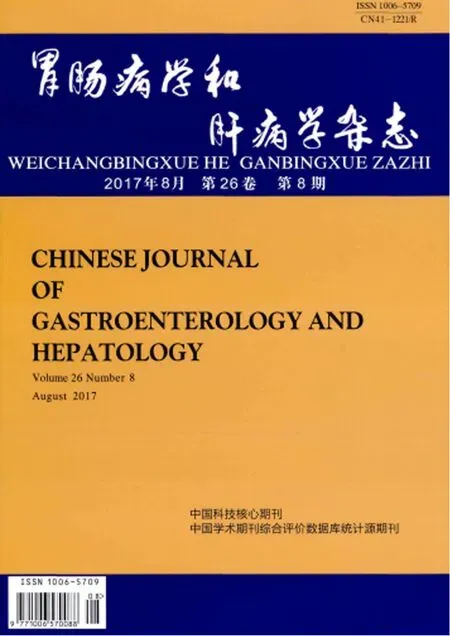萎缩性胃炎相关疾病概述
田 翀,高 青
1.重庆东南医院消化内科,重庆 401336;2.重庆医科大学附属第一医院消化内科
萎缩性胃炎相关疾病概述
田 翀1,高 青2
1.重庆东南医院消化内科,重庆 401336;2.重庆医科大学附属第一医院消化内科
萎缩性胃炎(atrophic gastritis,AG)是常见的胃部疾病,萎缩是指胃固有腺体的丧失,病理组织学类型包括黏膜萎缩、化生和异型增生。AG与胃癌的关系十分密切,已经引起广大学者的重视。胃黏膜经历慢性炎症-萎缩-肠化-异型增生等多个步骤,最终发展至胃癌。随着AG研究的深入,一些研究发现AG与其他消化系统器官及其他系统疾病存在一定联系,本文就这些相关疾病作一概述。
萎缩性胃炎;食管癌;结直肠肿瘤;自身免疫疾病;骨质疏松症;动脉粥样硬化
萎缩性胃炎(atrophic gastritis,AG)是常见的胃部疾病,包括多灶萎缩性胃炎和自身免疫性萎缩性胃炎(autoimmune atrophic gastritis,AAG)两种类型。我国大部分AG是多灶萎缩性胃炎,与幽门螺旋杆菌(Helicobacter pylori,H.pylori)感染、化学损伤(胆汁反流、NSAIDs、吸烟、酗酒等)有关。H.pylori感染、AG和胃癌之间的关系研究已比较透彻,本文主要对目前研究比较多的AG相关疾病作一概述。
1 食管疾病
胃食管反流病(gastroesophageal reflux disease,GERD)的典型症状为反酸、烧心,AG可能与GERD症状呈负相关[1]。Kim等[2]将1 555例接受上消化道内镜检查的志愿者作为研究对象,对他们进行GERD症状的问卷调查,并分为以下两组:GERD症状组和无GERD症状组。其中314例(20.2%)有GERD症状至少1周1次,1 241例(79.8%)无GERD症状。开放型AG(4.1%vs8.9%)、中度或重度AG(1.9%vs4.8%)的发病率在GERD症状组显著降低(P<0.05)。GERD症状与内镜下黏膜萎缩程度和组织学萎缩分数呈负相关。Tenca等[3]开展一项前瞻性研究,观察41例慢性AAG患者,发现胃酸反流很少发生,而非酸反流比较常见。
食管癌的两种主要的组织学类型是食管腺癌和食管鳞状细胞癌(esophageal squamous cell carcinoma,ESCC)。Almodova等[4]对当地人群AG与ESCC之间的关系进行研究,单变量分析表明AG是ESCC的一种独立危险因素,ESCC的发病率增加5.332倍(95%CI:1.55~18.30,P=0.008)。一项Meta分析指出AG使ESCC的风险增加2~3倍[5]。Cook[6]的研究同样认为AG与ESCC有关,并且证实两者间的因果联系可能为非酸反流。也有关于食管腺癌与AG的报道[7-8]。有研究[9-10]表明,上消化道微环境与食管癌关系密切,AG时胃黏膜腺体萎缩,胃酸分泌减少,导致上消化道微环境发生改变,从而使食管癌的发病率增加。
2 胃增生性息肉
Buyukasik等[11]回顾性分析2006年-2012年55 987例上消化道内镜检查报告,收集到66例上消化道息肉资料,息肉的病理学类型主要是增生性息肉(66.7%)。组织病理学分析发现AG30例(50.84%),H.pylori感染33例(55.9%),肠上皮化生(intestinal metaplasia,IM)19例(32.20%)。39.02%增生性息肉患者有IM,56.09%增生性息肉患者有AG。证明增生性息肉通常与H.pylori感染和AG有关。Moura等[12]的研究也认为胃增生性息肉与AG有关。胃增生性息肉通常发生在胃黏膜慢性炎症的基础之上,AG的存在反映胃黏膜受到长期慢性炎症刺激,在这种炎性环境下可能会出现黏膜的反应性增生。
3 结直肠肿瘤
目前关于H.pylori感染与结直肠肿瘤(colorectal neoplasm, CRN)的研究比较多见。Sonnenberg等[13]的大规模研究(n=2 195)表明H.pylori(+)组晚期CRN发病率增加了2.21倍。Inoue等[14]也证明H.pylori感染在一定程度上增加CRN风险。一些Meta分析和大样本研究均提示两者之间存在相关性[15-17]。然而以上研究并未对AG的情况进行分析。Lahner等[18]对AG与CRN的关系进行了研究,评估高胃泌素AG是否与结直肠病变的风险升高有关。研究包括160例高胃泌素血症AG患者和160名健康对照者。28例AG患者和36例对照者发现结直肠肿瘤性病变(P=0.33),观察组和对照组在结直肠腺瘤(10.6%vs13.1%,P=0.60)和结直肠癌(6.9%vs9.4%,P=0.54)的发病频率上无显著性差异。证明高胃泌素血症AG与CRN发展的更高可能性无相关性(OR=1.03, 95%CI:0.34~3.16)。然而,这项研究中大部分AG无活动性H.pylori感染,并且抗壁细胞抗体(anti parietal cell antibody,APCA)阳性,这项研究的结果可能与H.pylori感染引起的AG的结果意义不同。Lee等[19]全面分析了H.pylori感染、AG、CRN之间的联系,研究6 351例年龄≥40岁进行结肠镜初筛检查的健康志愿者。年龄(51.7±8.1)岁,3 491例(54.9%) ≥50岁。2 497例(39.2%)患有CRN,316例(5.0%)患有晚期CRN,1 989例(31.3%)有AG,3 896例(61.3%)有H.pylori感染。H.pylori感染者总体CRN及晚期CRN的患病率与无H.pylori感染者相比均显著升高(41.9%vs35.2%,P<0.001)及(5.7%vs3.9%,P=0.001)。单变量分析表明,H.pylori感染与晚期CRN有关(OR=1.49,95%CI:1.17~1.91,P=0.001)。对临床相关的混杂因素(年龄、性别、结直肠癌家族史、BMI、代谢综合征、吸烟、饮酒)进行调整后,证实H.pylori感染与晚期CRN的风险增加有关(OR=1.34,95%CI:1.04~1.72,P=0.023)。2 148例H.pylori(-)AG(-),307例H.pylori(-)AG(+),2 214例H.pylori(+)AG(-),1 682例H.pylori(+)AG(+)。H.pylori(+)AG(+)组总体CRN及晚期CRN的患病率均显著升高,H.pylori(-)AG(+) 对于任何类型CRN都不是独立危险因素,提示H.pylori相关性AG提高CRN风险。该结果与另外一项研究结果相符,认为H.pylori阳性胃炎和IM增加CRN风险,但是H.pylori阴性胃炎并不增加其风险[13]。H.pylori(+)AG(+)组较H.pylori(+)AG(-)组晚期CRN的发病率更高(7.3%vs4.4%,P<0.001)。H.pylori(+)AG(+)与晚期CRN的风险显著相关(OR=1.40, 95%CI:1.03~1.91,P=0.030),而H.pylori(+)AG(-)与晚期CRN的风险无关。提示H.pylori感染的长期存在可能对晚期CRN的发展至关重要,因为AG通常是H.pylori长期感染的结果。Inoue等[20]对99例经历了CRN内镜下切除术的患者进行结肠镜监测,前瞻性调查CRN复发情况。在对混杂因素进行调整后,AG被认为是CRN复发的独立危险因素(HR=2.72, 95%CI:1.33~5.57),而H.pylori(+) AG (-)并不认为是CRN复发的独立危险因素。CRN在AG患者中复发时间更早,复发频率与非AG患者相比更高(22 573/100 000人年, 11 089/100 000人年,P=0.029)。胃黏膜萎缩的范围越广,CRN复发的风险越高。这些结果表明,AG的存在和发展显著增加CRN复发的风险,H.pylori感染参与到CRN的发展过程。有研究推测,由于胃泌素对上皮细胞生长和增殖有营养作用,可能促成CRN发生。但是上述研究表明,在高胃泌素的AG环境中,H.pylori(-)胃炎并不引起CRN发病率升高,提示高胃泌素血症可能并非促成CRN发生的主要原因。H.pylori感染可能是引起CRN发病的关键因素,H.pylori(+)AG(-)胃炎不引起CRN发病增加,提示H.pylori感染的长期存在及胃黏膜萎缩程度是CRN发生、发展的关键,相关机制有待进一步研究证实。
4 自身免疫疾病
自身免疫性多内分泌腺病综合征Ⅲ型的特点是自身免疫性甲状腺疾病(autoimmune thyroid disease, ATD)与其他自身免疫性疾病如糖尿病、秃头症、恶性贫血、白癜风、AAG共存。Castoro等[21]为了证明ATD与AAG之间存在紧密联系,评估ATD患者AAG的患病率。2004年-2014年,对242例ATD患者进行APCA、维生素B12、铁蛋白、血清铁、血红蛋白、红细胞计数筛查,APCA阳性者接受胃镜检查。研究发现,57例(23.5%)患者APCA阳性,其中33例(57.8%)有Graves病,24例(42.1%)有桥本甲状腺炎,10例(17.5%)出现贫血,14例(24.5%)有维生素B12缺乏,9例(15.7%)有铁缺乏。研究资料证实,AAG与ATD之间存在高度相关性。AAG和原发性甲状旁腺功能亢进(primary hyperparathyroidism, PHPT)有共存现象,但是范围和潜在机制仍然知之甚少。Massironi等[22]开展一项前瞻性研究,评估AAG组和PHPT组患者中两者之间的关系。收集2005年-2012年,经过病理组织学确认的107例AAG患者及149例PHPT患者资料。常规实验室检查包括血清钙浓度、甲状旁腺激素(parathyroid hormone, PTH)、血清胃泌素和嗜铬素A(chromogranin A, CgA)。对高PTH水平的AAG患者,进一步评估离子钙和25(OH)-维生素D水平。所有AAG和PHPT患者均接受上消化道内镜检查。107例AAG患者中,9例(8.4%)有PHPT,13例(12.1%)有维生素D缺乏引起的继发性甲状旁腺功能亢进。149例PHPT患者中,11例(7.4%)有AAG。AAG患者无论是否伴有甲状旁腺功能亢进(原发或继发),都有相似的胃泌素和CgA水平;PHPT患者无论是否伴有AAG,都有相似的钙离子和PTH水平。AAG患者中PHPT的发病率是普通人群的3倍(8.4%vs1%~3%),PHPT患者中AAG的患病率是普通人群的4倍(7.4%vs2%)。
5 骨质疏松症
骨质疏松症对老龄化社会造成巨大威胁,胃酸缺乏的环境是骨质疏松症的危险因素。Aasarød等[23]研究AG组与健康对照组骨密度和骨质量可能存在的差异。17例AG患者,年龄(54±13)岁,41例年龄与性别相匹配的对照组。结果发现,AG组与对照组相比,腰椎骨密度Z-score (-0.324±1.096vs0.456±1.262,P=0.030)更低,腰椎(P=0.046)及全髋关节(P=0.019)骨质疏松症频率更高。Mizuno等[24]评估H.pylori感染与AG是否可作为骨质条件的生物标记。研究230例50~60岁的男性,使用血清抗体检测H.pylori感染,在血清胃蛋白酶原Ⅰ和Ⅱ标准的基础上诊断AG,检测参与者的骨密度。结果H.pylori感染和AG均显著增加骨小梁密度降低的风险(OR=1.83, 95%CI:1.04~3.21,P=0.03)和(OR=2.22, 95%CI:1.17~4.22,P=0.01)。与H.pylori(-)AG(-)的个体相比,H.pylori(+)AG(+)的个体是骨小梁密度降低的显著高危人群(OR=2.65, 95%CI:1.27~5.55,P=0.01)。H.pylori感染和AG的血清学诊断,可以被建议用于骨质疏松症的风险评估。韩国学者[25]调查了AG与>60岁的绝经后妇女骨质疏松症之间的关系。研究包括401例绝经后妇女,对她们进行骨密度测量。骨质疏松组AG的比例高于非骨质疏松组(56.9%vs43.1%)。按照正常、骨量减少、骨质疏松症的分类,观察到骨质疏松与AG的比例呈线性关系。多元逻辑回归分析显示AG的存在增加骨质疏松的机率(OR=1.89, 95%CI:1.15~3.11)。钙离子在酸性条件下呈电离状态,在小肠吸收。AG时胃酸分泌减少,钙离子的吸收减少,从而对骨质产生不利影响。
6 动脉粥样硬化
Torisu等[26]的研究结果指出,不管H.pylori感染的情况如何,AG的存在与动脉粥样硬化有关。Senmaru等[27]调查了一般日本人群中AG与冠状动脉疾病(coronary artery disease, CAD)的关系。在2 633例研究对象中,531例(20.2%)被诊断为AG。AG组与非AG组相比,CAD的发病率更高(5.8%vs2.8%,P=0.0005)。多元逻辑回归分析表明,AG与CAD独立相关(OR=1.67, 95%CI:1.03~2.72),在对混杂因素(年龄、性别、肥胖、高血压、糖尿病、血脂异常、高尿酸血症、吸烟、饮酒)进行调整后,结果仍然提示AG是CAD的独立危险因素。AG影响CAD发病率的机制还不清楚,可能与胃黏膜的慢性炎症有关,有待进一步研究证实。
7 小结
AG是胃黏膜一种慢性疾病,与自身免疫、H.pylori感染、化学损伤等因素密切相关。胃黏膜腺体萎缩,胃酸分泌减少,不仅使胃内微环境受影响,同时也对邻近脏器及其他系统造成不良影响。因此,AG的预防与治疗显得尤为重要。只有加深对AG及其相关疾病的认识,才能对AG有更加全面的了解,为后续的研究奠定基础。然而,由于地区发病率、纳入样本数量、研究方法的不同,部分的研究结果存在一定的争议,缺乏大样本、多中心的数据支持,上述结果还有待更多的研究来进一步论证。
[1] Kim DH, Kim GH, Kim JY, et al. Endoscopic grading of atrophic gastritis is inversely associated with gastroesophageal reflux and gastropharyngeal reflux [J]. Korean J Intern Med, 2007, 22(4): 231-236.
[2] Kim TS, Park DI, Park JH, et al. Association between atrophic gastritis and gastroesophageal reflux symptoms [J]. Hepatogastroenterology, 2013, 60(127): 1583-1587.
[3] Tenca A, Massironi S, Pugliese D, et al. Gastro-esophageal reflux and antisecretory drugs use among patients with chronic autoimmune atrophic gastritis: a study with pH-impedance monitoring [J]. Neurogastroenterol Motil, 2016, 28(2): 274-280.
[4] Almodova Ede C, de Oliveira WK, Machado LF, et al. Atrophic gastritis: risk factor for esophageal squamous cell carcinoma in a Latin-American population [J]. World J Gastroenterol, 2013, 19(13): 2060-2064.
[5] Islami F, Sheikhattari P, Ren JS, et al. Gastric atrophy and risk of oesophageal cancer and gastric cardia adenocarcinoma-a systematic review and meta-analysis [J]. Ann Oncol, 2011, 22(4): 754-760.
[6] Cook MB. Non-acid reflux: the missing link between gastric atrophy and esophageal squamous cell carcinoma? [J]. Am J Gastroenterol, 2011, 106(11): 1930-1932.
[7] Bornschein J. Response to: oesophageal adenocarcinoma and atrophic gastritis- different viewpoints on the junction [J]. Eur J Gastroenterol Hepatol, 2015, 27(8): 985-986.
[8] Matuchansky C. Oesophageal adenocarcinoma and atrophic gastritis [J]. Eur J Gastroenterol Hepatol, 2015, 27(8): 984-985.
[9] Yang L, Chaudhary N, Baghdadi J, et al. Microbiome in reflux disorders and esophageal adenocarcinoma [J]. Cancer J, 2014, 20(3): 207-210.
[10] Yu G, Gail MH, Shi J, et al. Association between upper digestive tract microbiota and cancer-predisposing states in the esophagus and stomach [J]. Cancer Epidemiol Biomarkers Prev, 2014, 23(5): 735-741.
[11] Buyukasik K, Sevinc MM, Gunduz UR, et al. Upper gastrointestinal tract polyps: what do we know about them? [J]. Asian Pac J Cancer Prev, 2015, 16(7): 2999-3001.
[12] Moura EG, Domingos TA, Alvarado H, et al. Hyperplastic polyp with neoplastic transformation in a patient with atrophic gastritis and multiple gastric neuroendocrine tumors [J]. Rev Gastroenterol Mex, 2012, 77(2): 96-98.
[13] Sonnenberg A, Genta RM. Helicobacter pylori is a risk factor for colonic neoplasms [J]. Am J Gastroenterol, 2013, 108(2): 208-215.
[14] Inoue I, Kato J, Tamai H, et al. Helicobacter pylori-related chronic gastritis as a risk factor for colonic neoplasms [J]. World J Gastroenterol, 2014, 20(6): 1485-1492.
[15] Wu Q, Yang ZP, Xu P, et al. Association between Helicobacter pylori infection and the risk of colorectal neoplasia: a systematic review and meta-analysis [J]. Colorectal Dis, 2013, 15(7): e352-e364.
[16] Rokkas T, Sechopoulos P, Pistiolas D, et al. The relationship of Helicobacter pylori infection and colon neoplasia, on the basis of meta-analysis [J]. Eur J Gastroenterol Hepatol, 2013, 25(11): 1286-1294.
[17] Venerito M, Selgrad M, Malfertheiner P. Helicobacter pylori: gastric cancer and extragastric malignancies - clinical aspects [J]. Helicobacter, 2013, 18 Suppl: 39-43.
[18] Lahner E, Sbrozzi-Vanni A, Vannella L, et al. No higher risk for colorectal cancer in atrophic gastritis-related hypergastrinemia [J]. Dig Liver Dis, 2012, 44(9): 793-797.
[19] Lee JY, Park HW, Choi JY, et al. Helicobacter pylori infection with atrophic gastritis is an independent risk factor for advanced colonic neoplasm [J]. Gut Liver, 2016, 10(6): 902-909.
[20] Inoue I, Kato J, Yoshimura N, et al. Elevated risk of recurrent colorectal neoplasia with Helicobacter pylori-associated chronic atrophic gastritis: a follow-up study of patients with endoscopically resected colorectal neoplasia [J]. Mol Clin Oncol, 2013, 1(1): 75-82.
[21] Castoro C, Le Moli R, Arpi ML, et al. Association of autoimmune thyroid diseases, chronic atrophic gastritis and gastric carcinoid: experience from a single institution [J]. J Endocrinol Invest, 2016, 39(7): 779-784.
[22] Massironi S, Cavalcoli F, Rossi RE, et al. Chronic autoimmune atrophic gastritis associated with primary hyperparathyroidism: a transversal prospective study [J]. Eur J Endocrinol, 2013, 168(5): 755-761.
[23] Aasarød KM, Mosti MP, Stunes AK, et al. Impaired skeletal health in patients with chronic atrophic gastritis [J]. Scand J Gastroenterol, 2016, 51(7): 774-781.
[24] Mizuno S, Matsui D, Watanabe I, et al. Serologically determined gastric mucosal condition is a predictive factor for osteoporosis in Japanese men [J]. Dig Dis Sci, 2015, 60(7): 2063-2069.
[25] Kim HW, Kim YH, Han K, et al. Atrophic gastritis: a related factor for osteoporosis in elderly women [J]. PLoS One, 2014, 9(7): e101852.
[26] Torisu T, Takata Y, Ansai T, et al. Possible association of atrophic gastritis and arterial stiffness in healthy middle-aged Japanese [J]. J Atheroscler Thromb, 2009, 16(5): 691-697.
[27] Senmaru T, Fukui M, Tanaka M, et al. Atrophic gastritis is associated with coronary artery disease [J]. J Clin Biochem Nutr, 2012, 51(1): 39-41.
(责任编辑:陈香宇)
Overview of correlation diseases of atrophic gastritis
TIAN Chong1,GAO Qing2
1. Department of Gastroenterology, Chongqing Dongnan Hospital, Chongqing 401336; 2. Department of Gastroenterology, the First Affiliated Hospital of Chongqing Medical University, China
Atrophic gastritis(AG) is a common disease of stomach, atrophy refer to the loss of inherent gastric glands, histopathological type including mucosa atrophy, metaplasia and hyperplasia. AG is close to gastric cancer and it has caused the attention of many scholars. Gastric mucosa experiences multiple steps such as chronic inflammation-atrophy-intestinal metaplasia-hyperplasia, eventually to gastric cancer. With the deepening of AG research, some studies have found that there is a connection in other diseases of the digestive organs, other systems with AG. This paper will give an overview of AG correlation diseases of AG.
Atrophic gastritis; Esophagus cancer; Colorectal neoplasm; Autoimmune disease; Osteoporosis; Atherosclerosis
10.3969/j.issn.1006-5709.2017.09.026
R573.3
:A
:1006-5709(2017)09-1071-04
:2016-11-02
田翀,主治医师,硕士,研究方向:消化系统肿瘤。E-mail:tianchonghn@163.com
高青,主任医师,硕士生导师。E-mail:981051852@qq.com

